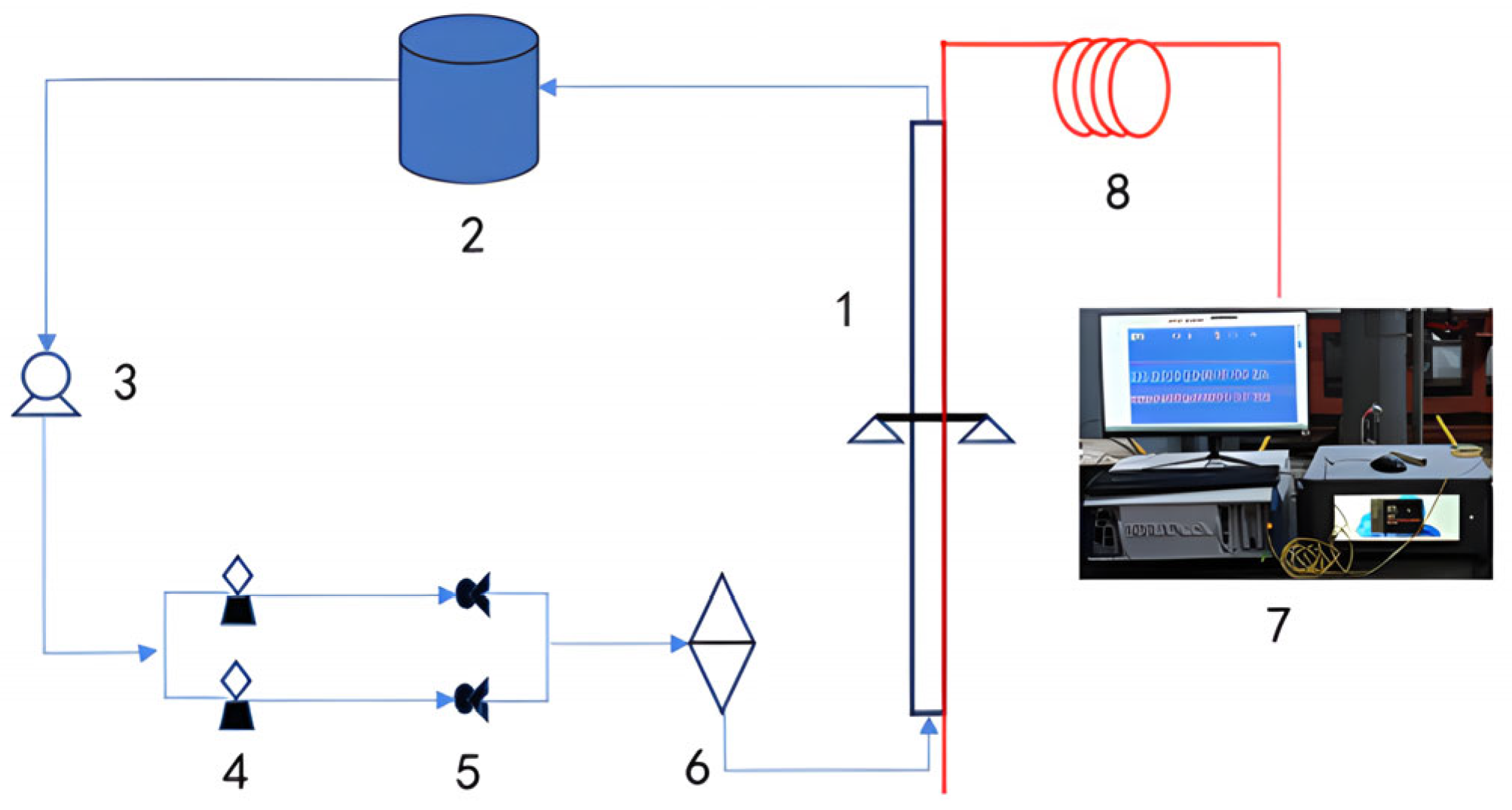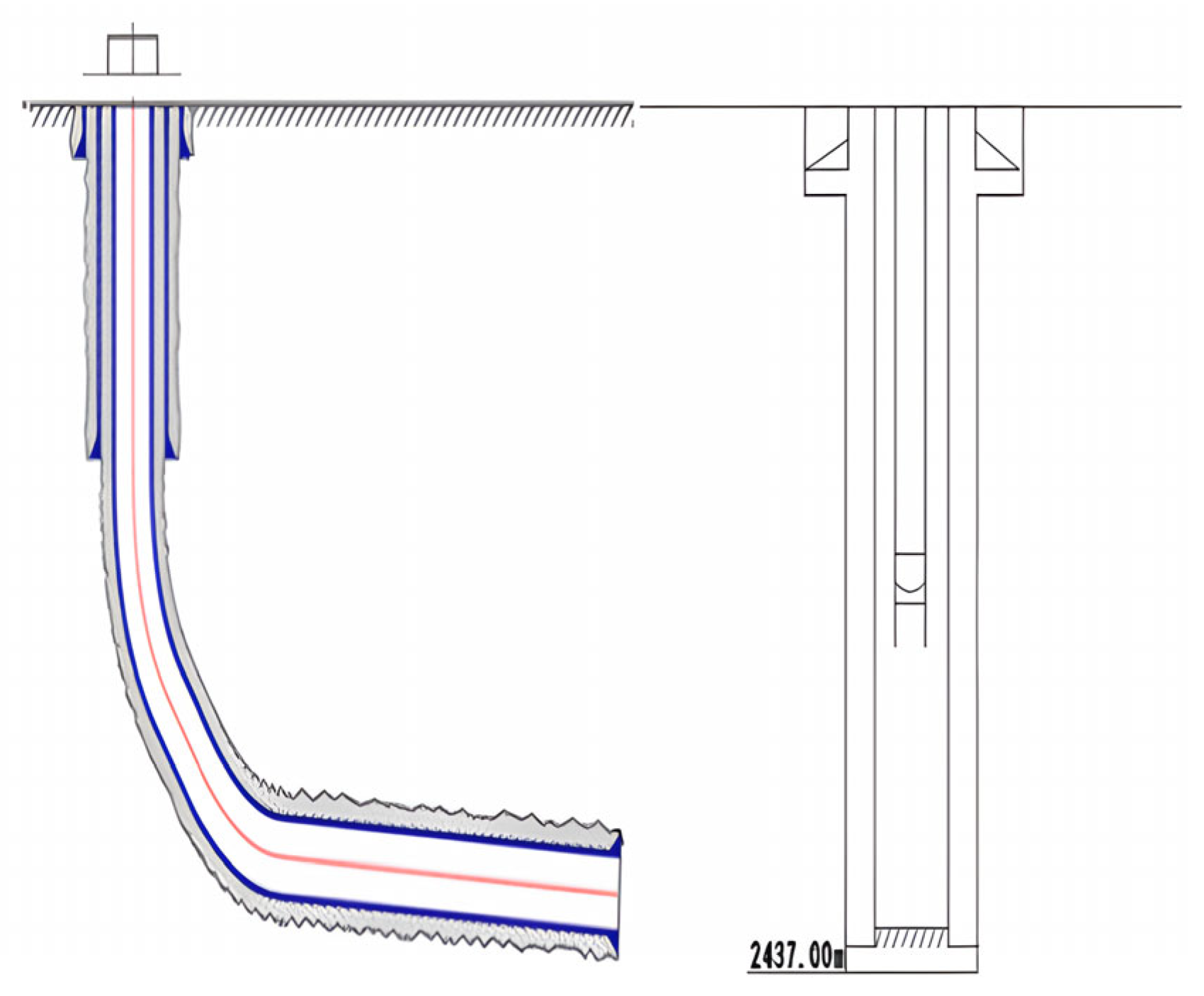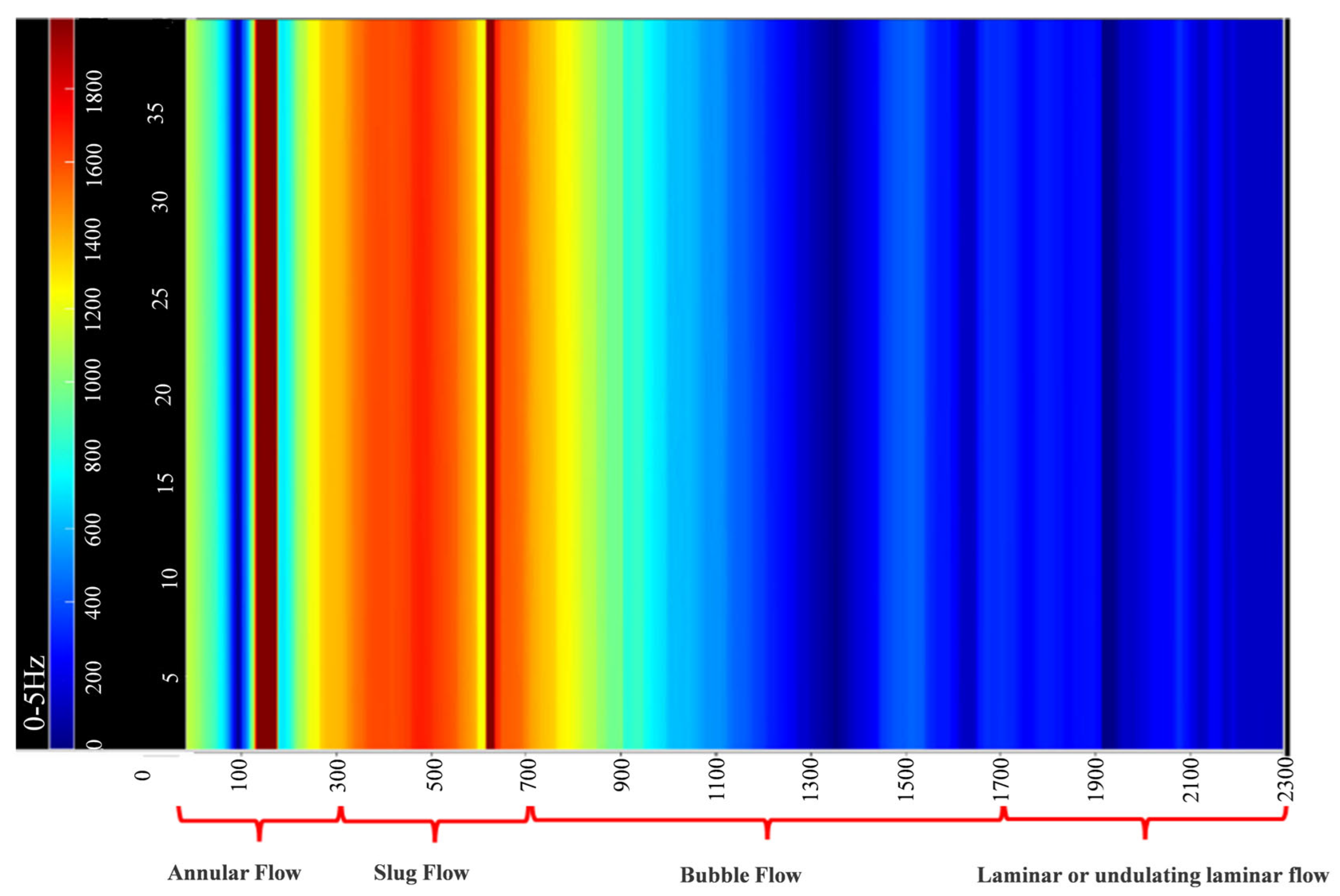Study on Multiphase Flow in Horizontal Wells Based on Distributed Acoustic Sensing Monitoring
Abstract
1. Introduction
2. Fiber Optic Monitoring Experiment of Multiphase Flow in Horizontal Wells
2.1. Experimental Setup
2.2. Experimental Scheme
3. Analysis of Experimental Results
3.1. Influence of Gas Flow Rate on Acoustic Response
3.2. Influence of Inclination Angle on Acoustic Response
3.3. Influence of Flow Pattern on Acoustic Response
4. Field Case Analysis
4.1. Well X
4.2. Well Y
5. Conclusions
Author Contributions
Funding
Data Availability Statement
Acknowledgments
Conflicts of Interest
References
- Alkhalifeh, K.; Rmili, H.; Hakim, B.; Sobahi, N.; AL-Turki, Y. Design of Microwave Antenna Array for Imaging of Multiphase Flows in Polypropylene Pipes. Int. J. Antennas Propag. 2021, 2021, 6636885. [Google Scholar] [CrossRef]
- Wu, Y.Y. Study on Intelligent Imaging Method of Multiphase Flow Production Profile Logging for Horizontal Wells. Ph.D. Thesis, Yangtze University, Jingzhou, China, 2024. Available online: https://kns.cnki.net/kcms2/article/abstract?v=oWJgMrFo8ufxU0raR8JOkHom1iD23NLjsh3_TNE0DQnx9U3Zp6R8xV_K9bhz-4esJiy6kd6v3Dmn2bztK_-5uVgreuzOaxm-8s8j1ac1sG8R3gsUStI8lV18TEsx6XWJPIq0dgidHjogVZJUfIjkFEnTyiT5nHm-OAWMh8bw8_PLQvoQhDX1xA==&uniplatform=NZKPT (accessed on 23 March 2025).
- Shams, R.; Tavakoli, A.; Shad, S. Experimental Investigation of Two-Phase Flow in Horizontal Wells: Flow Regime Assessment and Pressure Drop Analysis. Exp. Therm. Fluid Sci. 2017, 88, 55–64. [Google Scholar] [CrossRef]
- Qi, G. Study on Two-Phase Flow Pattern Recognition Based on Feature Extraction Method of Cross-Sectional Measurement Information. Ph.D. Thesis, Tianjin University, Tianjin, China, 2006. Available online: https://kns.cnki.net/kcms2/article/abstract?v=oWJgMrFo8uexzoEv6aXt_Xku5UkzwfCroGOcf7o-QF_ylhVBSK55ee1tVvh-oSR6DyrQnNjt94Vizd4hf8_eE8qcbK6oRrvLZPtpEyLzsCmnbGL8UKSZbh0DROopuaZA3fMWFA-OjlCoZmXd89Q65rX4Yi8AdsP18gjau4OHR1M=&uniplatform=NZKPT (accessed on 5 April 2025).
- Zhao, D.; Cao, X.; Zhang, Y.; Cui, M.; Zhang, N. Gas-Liquid Two-Phase Flow Pattern Recognition Method Based on Ultrasonic Technology in Horizontal Pipes. Oil Gas Storage Transp. 2014, 33, 165–171. [Google Scholar]
- Huang, C.H.; Hu, J.H.; Liu, X.B.; Yu, C.D.; Luo, S.Y. Experimental Analysis of Oil-Water Two-Phase Flow Pattern Based on High-Speed Camera and Multi-Parameter Combination. Logging Technol. 2014, 38, 526–529. Available online: https://kns.cnki.net/kcms2/article/abstract?v=oWJgMrFo8ud2x7FRLplGrBk7zS_kfsW83onuDXjjeczqyBwmfO4frPVHbL8ltEO-jCNoC3cerXpDpYzy2QFTi5PjAkLaYM25lxDj2RlJVJinKgQzQ-7lXTqAQrKtAp8ZG2WQMUrmMxtvygFXX2yep59oEhOjhLAgHAEEXAqUX3g=&uniplatform=NZKPT (accessed on 25 March 2025).
- Chang, D.K.; Xue, T.; Zhang, Y.T. Fuzzy Recognition of Gas-Liquid Two-Phase Flow Pattern Based on High-Speed Photography Sensor. Sens. Microsyst. 2016, 35, 58–60. [Google Scholar]
- Li, Z.B.; Wu, Y.X. Application of Gamma Ray Attenuation Method in Identification of Horizontal Gas-Liquid Two-Phase Flow Pattern. J. Shipbuild. China 2007, 48, 398–404. Available online: https://kns.cnki.net/kcms2/article/abstract?v=oWJgMrFo8ufgmXiJifKsQOAbmomcpzlgbngRzx8wxjziT_8PtVdbDT0JligXgX0Bdmq_yo8LUGMxvsCn53h1sT9lxHePll9zkurIsRFNSfQNt9zm4vzORbN-MybjQqKZ0SeUi4jX2B2WBGCZyJbVfEY5YA4iRionz_Wsn2867wY=&uniplatform=NZKPT (accessed on 8 April 2025).
- Liu, H.; Wang, S.; Ye, Z.Y.; Zhou, W.; Li, Q. Application of Fiber Optic Sensing Technology in Oil and Gas Field Development. Pet. Geophys. 2024, 63, 707–717. [Google Scholar]
- Liu, H.; Mu, L.J.; Qi, Y.; Chen, W.B.; Bai, J.; Tu, Z.Y. Evaluation and Optimization Suggestions for Multi-Cluster Balance of Staged Fracturing Based on Fiber Optic Monitoring. Drill. Prod. Eng. 2024, 47, 1–7. Available online: https://kns.cnki.net/kcms2/article/abstract?v=oWJgMrFo8ucW-8zBB-XgUmbm_3nNHvnOdbBm0xnorT0bvHWcRAYSW83aMcd3SbXusEwkS_41je2QaSuTI4oOGj5DOk6J8wTgJH4JuhPL0t_UAMKJqzk8V9T1ctXLglGxf-AzJ4ShzEJxeq10Oima8ulgqtJf_mL712BfXOQuYWo=&uniplatform=NZKPT (accessed on 8 April 2025).
- Yuan, L.B.; Tong, W.J.; Jiang, S.; Yang, Y.H.; Meng, Z.; Dong, Y.K.; Rao, Y.J.; He, Z.Y.; Jin, W.; Liu, T.Y.; et al. Development Roadmap of Fiber Optic Sensing Technology in China. Acta Opt. Sin. 2022, 42, 9–42. [Google Scholar]
- Yu, G.; Sun, Q.; Ai, F.; Yan, Z.; Li, H.; Li, F. Micro-Structured Fiber Distributed Acoustic Sensing System for Borehole Seismic Survey. In Proceedings of the 2018 SEG International Exposition and Annual Meeting, Anaheim, CA, USA, 14–19 October 2018; OnePetro: Richardson, TX, USA, 2018. [Google Scholar]
- Shang, Y.; Sun, M.; Wang, C.; Yang, J.; Du, Y.; Yi, J.; Zhao, W.; Wang, Y.; Zhao, Y.; Ni, J. Research progress in distributed acoustic sensing techniques. Sensors 2022, 22, 6060. [Google Scholar] [CrossRef] [PubMed]
- Rao, Y.J. Research Progress on Long-Distance Distributed Fiber Optic Sensing Technology. Acta Phys. Sin. 2017, 66, 158–176. [Google Scholar]
- Wang, Z.; Zhang, B.; Xiong, J.; Fu, Y.; Lin, S.; Jiang, J.; Chen, Y.; Wu, Y.; Meng, Q.; Rao, Y. Distributed acoustic sensing based on pulse-coding phase-sensitive OTDR. IEEE Internet Things J. 2018, 6, 6117–6124. [Google Scholar] [CrossRef]
- Xiong, J.; Wang, Z.; Wu, Y.; Rao, Y. Single-shot COTDR using sub-chirped-pulse extraction algorithm for distributed strain sensing. J. Light. Technol. 2020, 38, 2028–2036. [Google Scholar] [CrossRef]
- Cai, H.W.; Ye, Q.; Wang, Z.Y.; Lu, B. Distributed Fiber Optic Acoustic Sensing Technology Based on Coherent Rayleigh Scattering. Laser Optoelectron. Prog. 2020, 57, 9–24. [Google Scholar]
- Liu, L.X. Experimental Study on Sound Monitoring of Wellbore Flow State. Ph.D. Thesis, China University of Petroleum, Qingdao, China, 2020. Available online: https://kns.cnki.net/kcms2/article/abstract?v=oWJgMrFo8uet4VbFUNgisT6pD3T8BjifS03YdviqDe-vI0gvGWdNqeq16fIvr2GekTM146i2X7T9Djpc-j0wkh-Acfa1WH2q_BMbOeV0nSocg9ZLW4Sk8FqR9ACX3AXFsXPQlDGEne1CC4tQmn6VWk0u_v8D7EmByKYoYXugp5c=&uniplatform=NZKPT (accessed on 17 June 2024).
- Liu, J.; Han, Y.; Wang, Z.; Liu, M. Identification method of wellbore fluid types based on distributed fiber optic acoustic monitoring data and machine learning. J. China Univ. Pet. (Ed. Nat. Sci.) 2023, 47, 107–114. [Google Scholar]
- Masoudi, A.; Newson, T.P. High Spatial Resolution Distributed Optical Fiber Dynamic Strain Sensor with Enhanced Frequency and Strain Resolution. Opt. Lett. 2017, 42, 290–293. [Google Scholar] [CrossRef] [PubMed]
- Silkina, T. Application of Distributed Acoustic Sensing to Flow Regime Classification. Master’s Thesis, Institutt for Petroleumsteknologi og Anvendt Geofysikk, Trondheim, Norway, 2014. [Google Scholar]
- Vahabi, N.; Selviah, D.R. Convolutional neural networks to classify oil, water and gas wells fluid using acoustic signals. In Proceedings of the 2019 IEEE International Symposium on Signal Processing and Information Technology (ISSPIT), Ajman, United Arab Emirates, 10–12 December 2019; IEEE: Piscataway, NJ, USA, 2019; pp. 1–6. [Google Scholar]
- Zhong, C.; Chen, J.; Leung, J.Y. Analysis of Downhole Temperature-Strain Response in Hydraulic Fracturing—A Coupled Geomechanics-Thermal-Flow Simulation Approach. Geoenergy Sci. Eng. 2025, 247, 213710. [Google Scholar] [CrossRef]
- Urmantseva, L.; Lees, G.; Wilma, K.; Godefroy, C.; Gysen, A.; Mao, Y. Production Profiling Optimization Enabled by the Development of Distributed Acoustic Sensing Technology. In Proceedings of the Abu Dhabi International Petroleum Exhibition and Conference, Abu Dhabi, United Arab Emirates, 2–5 October 2023; SPE: Tulsa, OK, USA, 2023; p. D031S084R008. [Google Scholar]












| Technology Name | Principle | Advantages | Limitations | Application Range |
|---|---|---|---|---|
| Tomographic Imaging | X-ray/CT scanning to reconstruct multiphase distribution maps | High spatial resolution; non-invasive | Complex equipment; high cost; limited to laboratory/industrial environments; requires dedicated hardware | Gas–liquid/solid multiphase flows |
| Ultrasonic Measurements | Analyzing flow states via acoustic signals | Non-invasive; suitable for opaque fluids | Limited spatial resolution; noise-sensitive; difficult for high-speed flows | Industrial pipelines, underwater |
| High-Speed Camera | Direct visualization of fluid motion | Intuitive observation; easy data interpretation | Only for transparent fluids; subjective; poor detail capture in high-speed flows | Laboratory-scale flow studies |
| Radioactive Attenuation | Detecting phase changes via radiation absorption | Non-invasive; suitable for high-density phases (e.g., oil/gas–water) | Health risks; high cost; strict regulatory compliance required | Industrial well monitoring |
| Electrical Conductivity Probes | Distinguishing phases via conductivity differences (e.g., gas–liquid) | Low cost; real-time; suitable for conductive fluids | Limited to two-phase flows (e.g., gas–liquid); ineffective for non-conductive phases (e.g., oil–gas) | Vertical/horizontal wells |
| Fiber Optics Sensing | Monitoring flow via optical signal scattering/refraction changes in fibers | Immune to electromagnetic interference; high spatial resolution; suitable for high-temperature/pressure environments | Requires precise installation; complex signal processing; high cost | Complex downhole environments |
| Microwave Resonance | Detecting dielectric constant differences via resonance frequency shifts | Non-invasive; penetrative (suitable for metal pipes); real-time monitoring | Low sensitivity to small dielectric contrasts; calibration required for complex flows | Metal pipelines |
| Electrical Capacitance Tomography (ECT) | Reconstructing multiphase cross-sections via capacitance measurements from electrode arrays | Low cost; non-invasive; suitable for gas–solid/liquid–solid two-phase flows | Low spatial resolution; sensitive to high-conductivity fluids (e.g., saline water) | Industrial pipelines, slurry transport |
| ML-Based Soft Sensing | Predicting flow states via machine learning models using velocity/pressure data | No dedicated hardware; flexible; integrates multisource data | Dependent on training data quality; limited generalization; requires continuous calibration | Complex multiphase flows |
| Wellbore Horizontal Angle | Flow Pattern | Total Gas–Water Flow Rate (m3/h) | Water Cut (%) |
|---|---|---|---|
| 15° | Bubble Flow | 0.493 | 33.87 |
| 15° | Slug Flow (Low Gas Volume) | 47.986 | 3.584 |
| 15° | Slug Flow (High Gas Volume) | 103.557 | 1.854 |
| 15° | Annular Flow | 1843.263 | 0.0095 |
| 30° | Bubble Flow | 1.923 | 8 |
| 30° | Slug Flow (Low Gas Volume) | 55.674 | 0.282 |
| 30° | Slug Flow (High Gas Volume) | 133.631 | 0.136 |
| 30° | Annular Flow | 1414.763 | 0.013 |
| Flow ID | Flow Pattern Description | Acoustic Energy Range (RMS. Energy × 10,000) (Dimensionless) | Depth Position (m) |
|---|---|---|---|
| 1 | Annular flow | 2~3 | 0–450 |
| 2 | Slug flow | >3 | 450–1530 |
| 3 | Bubble flow | 1.5~2 | 1550–1800 |
| 4 | Laminar flow or undulating laminar flow | 1~1.5 | 1800–2010 |
| 5 | Small slug flow | >3 | 2030–2170 |
| 6 | Laminar flow or undulating laminar flow | 1~1.5 | 2200–2390 |
| 7 | Small bubble flow | 1.5~2 | 2390–2410 |
| 8 | Laminar flow or undulating laminar flow | 1~1.5 | 2200–2600 |
| Flow ID | Flow Pattern Description | Acoustic Energy Range (RMS. Energy × 10,000) (Dimensionless) | Depth Position (m) |
|---|---|---|---|
| 1 | Unknown flow regime | 4~5 | 0–20 |
| 2 | Annular flow | 2.5~4 | 20–60,100–180 |
| 3 | Unknown flow regime | 4~5 | 200–250 |
| 4 | Slug flow | >5 | 250–780 |
| 5 | Unknown flow regime | 4~5 | 780–850 |
| 6 | Annular flow | 2.5~4 | 850–1050 |
| 7 | bubble flow | 2~3.5 | 1050–1550 |
| 8 | Laminar flow or undulating laminar flow | 1~1.5 | 1650–2300 |
Disclaimer/Publisher’s Note: The statements, opinions and data contained in all publications are solely those of the individual author(s) and contributor(s) and not of MDPI and/or the editor(s). MDPI and/or the editor(s) disclaim responsibility for any injury to people or property resulting from any ideas, methods, instructions or products referred to in the content. |
© 2025 by the authors. Licensee MDPI, Basel, Switzerland. This article is an open access article distributed under the terms and conditions of the Creative Commons Attribution (CC BY) license (https://creativecommons.org/licenses/by/4.0/).
Share and Cite
Zheng, R.; Fang, L.; Yang, D.; Deng, Q. Study on Multiphase Flow in Horizontal Wells Based on Distributed Acoustic Sensing Monitoring. Processes 2025, 13, 2280. https://doi.org/10.3390/pr13072280
Zheng R, Fang L, Yang D, Deng Q. Study on Multiphase Flow in Horizontal Wells Based on Distributed Acoustic Sensing Monitoring. Processes. 2025; 13(7):2280. https://doi.org/10.3390/pr13072280
Chicago/Turabian StyleZheng, Rui, Li Fang, Dong Yang, and Qiao Deng. 2025. "Study on Multiphase Flow in Horizontal Wells Based on Distributed Acoustic Sensing Monitoring" Processes 13, no. 7: 2280. https://doi.org/10.3390/pr13072280
APA StyleZheng, R., Fang, L., Yang, D., & Deng, Q. (2025). Study on Multiphase Flow in Horizontal Wells Based on Distributed Acoustic Sensing Monitoring. Processes, 13(7), 2280. https://doi.org/10.3390/pr13072280






